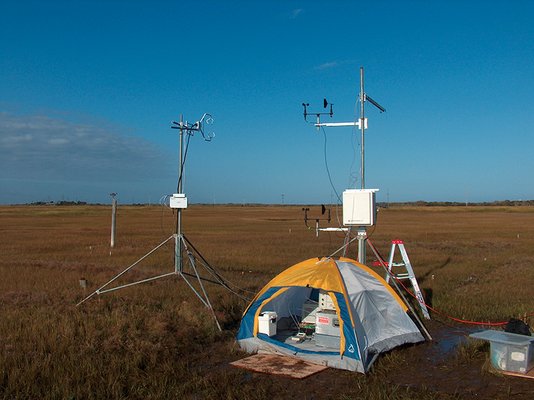
by Nicole Branan Thursday, January 5, 2012

John Reinfelder and Lora Smith measure elemental mercury gas volatilizing from the Great Bay Estuary in New Jersey. Courtesy of John Reinfelder
Elemental mercury — whether produced naturally by volcanoes or forest fires, or released from industrial sources such as power plants — is easily volatilized into the atmosphere; from there, it can settle in aquatic settings and enter the food chain. Now, a new study adds a twist by following the path of mercury from wetlands back into the atmosphere — and finds that more mercury is volatilized than previously thought.
Wetlands are an important stop in mercury’s travels: Rain washes pollutants into the watershed, where they collect and ultimately end up downstream in the sediments of an estuary. That makes wetlands “a trap for particles and therefore a trap for things that stick to particles, like mercury and other contaminants,” says John Reinfelder, an environmental scientist at Rutgers University in New Brunswick, N.J., co-author of a new study in the Journal of Geophysical Research. Wetlands are also important because they are the main place on the planet where mercury is converted into methylmercury, a neurotoxin that accumulates increasingly in organisms going up the food chain, from plankton to fish and birds to humans. Knowing what mechanisms allow the release of mercury from wetlands is important because “anytime you volatilize mercury out of an ecosystem, you are lowering the amount that could be converted to methylmercury,” Reinfelder says.
So Reinfelder and his colleague Lora Smith, also at Rutgers, set out to determine how and how much mercury is volatilized in wetlands. Most of the mercury that gets trapped in wetlands sits in sediments in its oxidized form, either as mercury sulfide or just bound to organic matter, Reinfelder says. In this form, it stays in the ground and can’t escape. But photochemical reactions due to sunlight can free mercury floating around in the water of lakes and the surface of the ocean as well as from dry soils, turning oxidized mercury attached to organic matter into elemental mercury. In this form, the metal can volatilize.
Reinfelder and Smith measured the amount of gaseous elemental mercury that volatilizes at different times of the day from two tidal salt marsh sites in New Jersey. The researchers calculated the mercury flux from measuring the wind speed profile and mercury concentrations close to the sediment as well as a few meters above the ground. The first site, the Secaucus High School Marsh, sits within one of the most industrialized regions of the East Coast, whereas the other, the Great Bay Estuary, is surrounded by national reserves and wildlife refuges, and is therefore thought to be one of the more unpolluted estuaries in the region.
But at both sites, the amount of mercury coming out of the sediment is higher than expected. “The values are about 10 times greater than what you would get from [completely] unpolluted soils,” says Joseph Yavitt, a biogeochemist at Cornell University in Ithaca, N.Y., who was not involved in the work. “That suggests that the speed at which the mercury is being cycled and recycled in wetlands may be greater than we previously expected,” he says. “If 10 times more is coming out, then 10 times more must be coming in, assuming that the mercury is not being depleted over time.”
Reinfelder and Smith also saw that mercury release rose and fell with incident solar radiation. That suggests that sunlight is the main driver for the volatilization of elemental mercury from both sites, they reported. “We saw almost identical relationships between the cumulative mercury flux and the amount of light that the sediments were exposed to at both sites,” Reinfelder says.
Both sites are sparsely vegetated, so a lot of bare sediment is exposed directly to the sun. Scientists had known that sunlight could help convert mercury into its elemental gas form, but so far few studies had looked for this effect in wetlands, Reinfelder says. “If you had a lot of vegetation to block the light from actually reaching most of the sediment surface, that could inhibit this effect,” he says.
There’s a paradox here: Although the volatilization of mercury means there is less that can be converted into methylmercury — which could be considered a good thing at a local level — the question is when and where the volatilized elemental mercury is going to deposit downwind, Reinfelder says. “At some point it’s going to start coming back down and it may come down at a place that is even more sensitive.”
Furthermore, although mercury from wetland sediments makes up only a minute amount of total mercury emissions, the results show that it can be an important source on a local level, Reinfelder says. “If you took the mercury emissions from all the salt marshes in the United States, it would only be about 3 percent of all industrial emissions. But on a local scale the emissions can be comparable to individual industrial emissions sources.”
In the end, Reinfelder says, the fact that sunlight triggers the release of mercury from wetlands “is neither a good thing nor a bad thing, it’s just a phenomenon that we need to quantify to understand the mercury cycle.” In fact, Yavitt adds, “there is very little literature on this, so these are interesting findings and they suggest that more work should be done.”
© 2008-2021. All rights reserved. Any copying, redistribution or retransmission of any of the contents of this service without the expressed written permission of the American Geosciences Institute is expressly prohibited. Click here for all copyright requests.